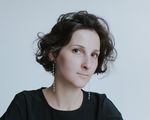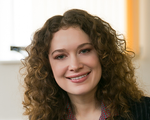About Success Builder
How do you find your place in life? How do you find something to do that both comes naturally to you and makes you happy? The answer is that you have to apply the knowledge you’ve gained from university and from life itself correctly. The Success Builder Project features HSE University graduates who have discovered themselves through an interesting business or an unexpected profession. The protagonists share their experiences and lessons learnt and talk about how they’ve made the most of the opportunities they were given.
Unexpectedly, one of last year’s trends was…mushrooms. Several startups have shown that mycelium is a suitable material for eco-friendly fabrics, fashionable foods and the manufacture of drugs to treat clinical depression. ‘Prototyping Future Cities’ Master’s Programme graduate Anna Budnikova took the mushroom trend one step further by inventing a building material she calls ‘mycokarst’. She tells Success Builder what the difference is between eco- and bio-materials, why to make water from air and design ‘passive homes’, and who urbanists are and how they are changing our cities.
How did you become interested in architecture?
I have been drawing since I was two. As a child, I first wanted to become an artist and, later, a fashion designer, but when I took some architecture courses, I became interested in volume and space. Before coming to HSE, I graduated with a degree in The Architecture of Residential and Public Buildings from the Kazan State University of Architecture and Engineering (KSUAE). Now I am developing my own company and learning from practical experience, including in the field of interior solutions.
Would you call yourself a designer of buildings?
That is essentially what I am. Architects don’t like to be called designers, but I am a designer of spaces. I am not very interested in technical details — you can find those in reference books or consult a professional engineer. I study materials, their physics and biology, and their ability to influence a person’s feelings in space — and, of course, on how much aesthetic pleasure they experience in that space. I want to discover something new and see something non-standard.
Is it possible to create a space that everyone will like?
When creating a public building, the criteria are, for the most part, obvious. It involves the creation of multi-storied open and accessible spaces that most people of all ages find psychologically and subconsciously attractive. It is something like an enclosed park with many different spaces inside. I was recently in Helsinki and was surprised at the number of public libraries where you could just go, drink coffee and read a book without having to register or show a pass. These are buildings with open atriums where people can find a cosy corner somewhere even though it is open to the public. Many European cities have one or more such buildings. But Russia still adheres to the paradigm of spatial restrictions that, in my opinion, is simply anti-humanistic and unwholesome.
It seems that you and the other graduates of the HSE Master’s Programme ‘Prototyping Future Cities’ are breaking that stereotype. How did you get into the university?
At KSUAE , I did my senior project on water management in architecture. I am interested in ecology and materials, and this gave rise to a Hydrological Cluster project for Kazan that I decided to develop further. For this, I received a grant to study at the Vysokovsky Graduate School of Urbanism at HSE.
I came to Moscow to work and bring my ideas to life, but I found just the opposite in practice: the architects building office space had vacant eyes, there was no communication with the authorities, and the whole field was so commercialized that it was impossible to build anything but shopping centres. My desire to go into science won out: drawing cookie-cutter buildings was not for me. The architectural bureaus wouldn’t let me speak with our clients because I wasn’t familiar enough with ‘how things are done in Moscow.’ I had done most of my interning abroad — in Berlin, London and Beijing. That taught me how things should be, but when I came to Russia, I understood that everything is done differently here.
I began wondering how and where I could implement the experience and innovations that matter most to me. That was when I learned about the Laboratory for Experimental Urban Design ‘Shukhov Lab’. The first time I went there and saw the prototype façade by architect Elena Mitrofanova, I immediately realized that the people here think the same way I do.
How did you get the grant?
For my Hydrological Cluster project, I received the first award of the D3 Natural Systems international competition in New York. When I found out that HSE and the Tatarstan authorities award a grant for the ‘Prototyping Future Cities’ Master’s Programme, I decided I would apply for it. I had something to show the professionals. I had to go through an extensive competitive process to win that grant, as well as bring my English up to the level the rules required.
As a result, I received a grant that allowed me to study at HSE and conduct research at the ‘Shukhov Lab’. Over time, the contrast between my studies and the office routine at the day job I still had became so great that I would run to the university to escape work at the end of the day. At first, I would leave a little earlier each day, and at one point I stopped going to work altogether. And even then, I never missed a project deadline.
I’d like to point out that no one needs to work eight hours in an office. Effectiveness comes not from how many hours you sit at your desk, but from your motivation and the results of your efforts. You need to listen to your body because it can create fantastic things. As our lives move increasingly online, I hope that even the most sceptical and ultraconservative employers recognize this.
Tell us about your ‘mycokarst’ master’s project. What is this material and how does it work?
Interestingly, this project also won an award in New York, albeit a different one — the Biodesign Challenge 2019 summit at MoMA. Throughout my studies, I maintained a focus on water, developing, among other things, ceramic surfaces that condense moisture as a response to a shortage of fresh water. But the ‘mycokarst’ project was a departure from this.
The rules of the grant stipulate that the proposed master’s project focus on Kazan. It happens that the city stands on karst sinkholes, which is a real problem. I saw it as an architectural task to strengthen this foundation and turned to biomaterials towards that end. I used mushroom spores, and the name ‘mycokarst’ refers to the mycelium of the mushrooms and the karst. Some researchers are studying ways to use bacteria to produce self-healing concrete, but only the Chinese are looking at mushroom spores. I realized that karst is similar to the structures that support these microorganisms. Spores deposit calcium, enabling the structure of the material to heal itself gradually.
My academic advisor, Elena Mitrofanova, supported this idea and now it has become a large-scale scientific project.
Traditional architects work with inanimate materials knowing that the structures they build will never go away, dissolve or disappear. What is it like working with living, moving materials?
Maintaining living materials within a given form is one of the tasks we have to solve now. Soil is a very fertile environment for mushrooms: it offers high aeration and many nutrients so, of course, today’s architects face the challenge of making biotechnology more aesthetic.
Progress has been made in the field of bioceramics that can produce a green façade and materials that absorb moisture for the growth of bacteria or green structures. But everything requires repeated testing and approvals for certain technological characteristics.
Biomaterials are our future: they could become a kind of infrastructure for buildings that replace such utilities as air conditioners and purifiers
Some biomaterials enrich the air with oxygen and provide natural ventilation. Such buildings can ‘breathe’ on their own.
Our architectural firm M-A SPACE currently specializes in designing energy-efficient buildings that, in particular, include supply and exhaust ventilation of premises that will help save energy — but in the future, this could be done with organic building materials. My research complements the work of the studio in this regard, but it takes a long time to put these ideas into practice.
Are builders in other countries already using biomaterials in construction?
Here and there, but definitely not in Russia. Eco-construction using wood and other natural, eco-friendly materials is a common phenomenon and still cutting-edge, but this is no longer very impressive. But building with living, ‘evolving’ materials that improve the ecology is something else entirely. It is a new and little-studied area. The challenge concerns not only the general mentality and the difficulty people have in accepting innovation, but also in the difficult climatic conditions for bacteria and other living systems. We have to carry out technical tests to ensure that the material has certain characteristics and then check it out at the engineering level. Climate change provides endless ground for experimentation and reflection, but implementation remains a question.
Prototypes of such materials are being made at the IAAC in Barcelona, MIT in the U.S., RMIT in Australia, the Bartlett School in London, and some others, but as far as I know, only the LafargeHolcim and Tegola companies have made any practical applications with them.
Do you have plans to create a business based on biomaterials?
Of course. Now I am working to overcome barriers to their acceptance and working on my patents. I am in talks with LargeHolcim, a major Swiss company that produces building materials, to run tests on ‘mycokarst’. I often speak at conferences and several foreign companies have approached me about putting our preliminary work into mass production.
The same applies to my ‘hydromatter’ that produces water from the air. The Moscow Department of Environmental Management has proposed implementing the project. The task now is to check all of the technical parameters and carry out thorough tests. Thus, two projects that hold great commercial promise are now in the final stages of development.
Why did you decide to create the M-A SPACE company?
After completing my master’s degree, I felt very frustrated at the prospect of working in an architectural office again. It turned out that a colleague who is an architect, engineer and designer of passive houses, was feeling pretty much the same way. So we decided to combine my interest in biomaterials with real-world innovative projects and began working for ourselves, maintaining control over copyrights and ideas. So far, we have found clients through connections and social contacts, but we are also developing our site and presenting our innovations at conferences.
How does all the ‘eco-hype’ influence architectural projects in general, and those in Russia in particular?
It is a major trend, and all kinds of architectural competitions are devoted to the fight against global warming. A popular focus right now is how architecture can help reduce CO2 emissions. Only a few entities in the world can afford to implement ecological experiments and very few specialists truly understand the finer points of energy efficiency.
However, M-A SPACE has implemented several projects in this field. These include a ‘passive house’ with zero energy consumption. Building such a structure requires what, for Russia, is an unusually high quality of construction. The idea that a passive building is much more expensive than a conventional one is a misconception. It’s just that in Russia, prices are inflated for the high-quality construction essential to energy-efficient buildings, whereas that level of work is the standard in Europe.
Because Russia has been subject to various destabilizing factors over its history, long-term thinking is not part of the general mentality. People here are used to looking at shorter periods and, therefore, show little interest in eco-trends — even though energy-efficient structures save money over the long term.
What architectural design problem do Russian cities face?
The problem is that Russian cities have no design: they are built to satisfy commercial goals and utilitarian functions. I could go on endlessly about Russia’s cockamamie urban spaces, roads and inexplicable buildings, although this problem is not as pronounced in Moscow as it is in many of the smaller cities. As someone who is extremely sensitive to air pollution, I can say that the environment is an even greater problem. Moscow has some large parks, but it would be good to have more public squares and green areas. I think we should have more people-friendly spaces of different sizes located throughout the city. It’s as if we can’t keep up with the Scandinavian countries that spend money on their citizens’ welfare and not on building new shopping centres.
In which parts of the world do you feel most comfortable?
I like Helsinki, Copenhagen and Berlin where literally every city space is made with people in mind. For example, there is access to water almost everywhere there. Not only can you relax, reflect and commune with nature, but also work outdoors in the fresh air. It’s one thing when you get off work and have to walk home along a dusty highway before collapsing in front of the TV, and quite another when you can go from work to the waterfront and just lose yourself in thought there.
What is an ‘urbanist’?
I first encountered the concept of ‘urbanism’ at the Shukhov Lab. Before that, I thought more in terms of a ‘designer of the architectural environment’ — that is, a person who is simply engaged in urban improvement.
At HSE, I began to see the city as an organism, to understand the environment and analyze its elements — from the ecology to public transport
Urbanism is a kind of global socio-architectural analytics. I mostly associate the profession of urbanist with the powers of the municipal authorities. Such major companies as Habidatum or Urbica essentially develop the technical mandate for the organization of the urban environment, and so on. But there is a real need for a link between architects, those who plan public spaces, analysts and the city officials who have the authority to implement well-thought-out solutions. At present, competitions are the only time they all come together. That is why it is an enormous challenge for specialists — and especially those who are not well known — to establish such communication with the authorities.














































































































































